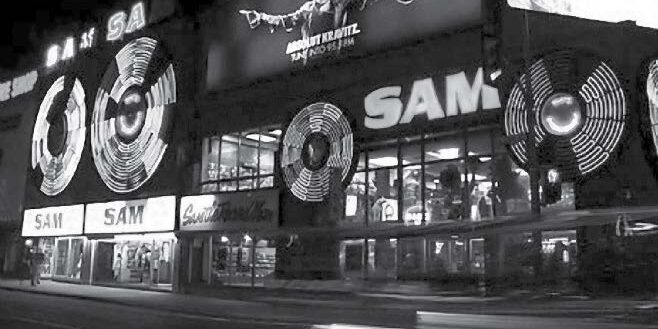By Peter Glaser
Toronto is a city in constant renewal, the old forever giving way to the new. With a vibrant and livable downtown core and sprawling suburban growth, little by way of contemporary architecture seems to be spared as the city reasserts itself. Moreover, a harsher northern climate seems to work against the retention of vintage neon signage once the tubes no longer glow. Nevertheless, there are treasures to be found, and these are among them:
1: Honest Ed’s
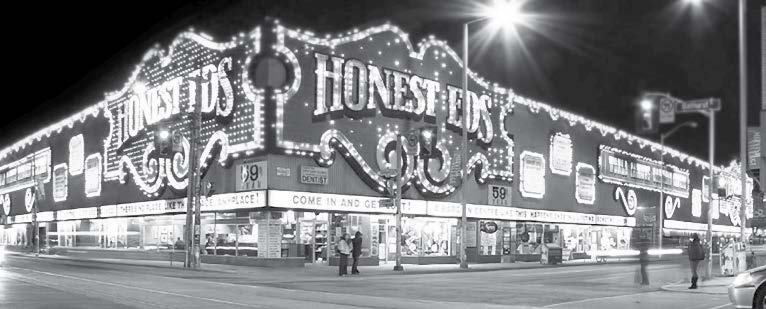
A quick glance at this place, and you might be given the impression that it is a transplanted Las Vegas casino – except that the sign speaks of honesty. Now in its sixty-first year, Honest Ed’s is a bargain hunter’s paradise, and an outright Toronto institution. Ed Mirvish (1914-2007) opened his discount store in 1948 and it has since grown to occupy an entire city block, radiating from the intersection of Bloor and Bathurst Streets in downtown Toronto.
I used to love riding the streetcar past this retail empire as a kid and be dazzled by the 23,000 blinking lights and all the cheesy advertising puns and taglines, such as “Only the floors are crooked” or “Come in and get lost!” Inside, the 160,000 square foot emporium provides ample pleasures for frugal shoppers and the plain curious alike, the latter perhaps seeking the ultimate in kitsch: a garish Elvis bust, gaudy religious paraphernalia (this pun is mine), or even prophylactics sold under the banner of “One size fits all.” If you can tolerate the glare of all the fluorescent tube lighting, a trip inside rewards the effort.
Ed Mirvish and his son, David, built a live theatre empire be- ginning in the 1960s after first saving and restoring the 1907 Beaux-Arts Royal Alexandra Theatre to its original splendor, and then building and buying other theatres, including the venerable Old Vic in London, England. They also opened half-a-dozen restaurants – consuming another city block on King Street West – beside the Royal Alex to capitalize on the appetites of their theatre going audiences.
When the Mirvishes later closed and sold off the valuable property these restaurants occupied in the 1990s, much of the half-century of theatre memorabilia that lined the walls – posters, autographed photos and artifacts – was transferred to Honest Ed’s and now provides an enriching museum-like backdrop to the merchandise and the countless hand-painted signs with their cheesy yet self-deprecating humor.
2: Massey Hall
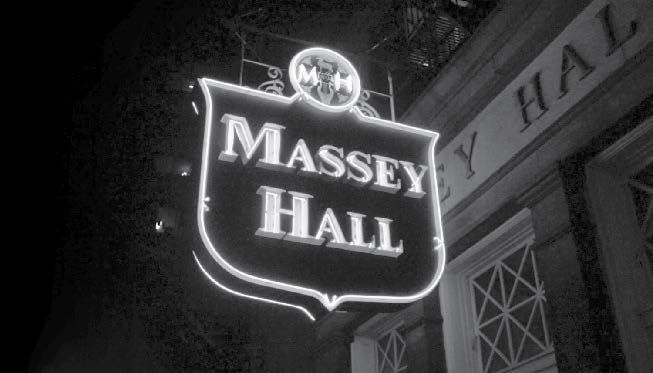
This simple but elegant neon sign graces the main entrance to the city’s most revered performance hall. Opened in 1894 as Massey Music Hall, this Toronto venue is celebrated for its magnificent acoustics and its esteemed performance history, a who’s who of world talent that includes the legendary 1953 meeting of Dizzy Gillespie, Charlie Parker, Charles Mingus, Bud Powell and Max Roach – hailed by many as the greatest evening ever in jazz. Any musician worthy of their chops will opt to play this intimate 2,753 seat venue even if they can fill larger and more lucrative performance spaces. For many, however, Massey Hall is synonymous with Gordon Lightfoot who has played the hall almost annually since 1967. During his 1970s heyday, he would play runs of 9-10 nights during a tour, and has performed there over 160 times, more than any other entertainer.
3: The Eglinton Theatre
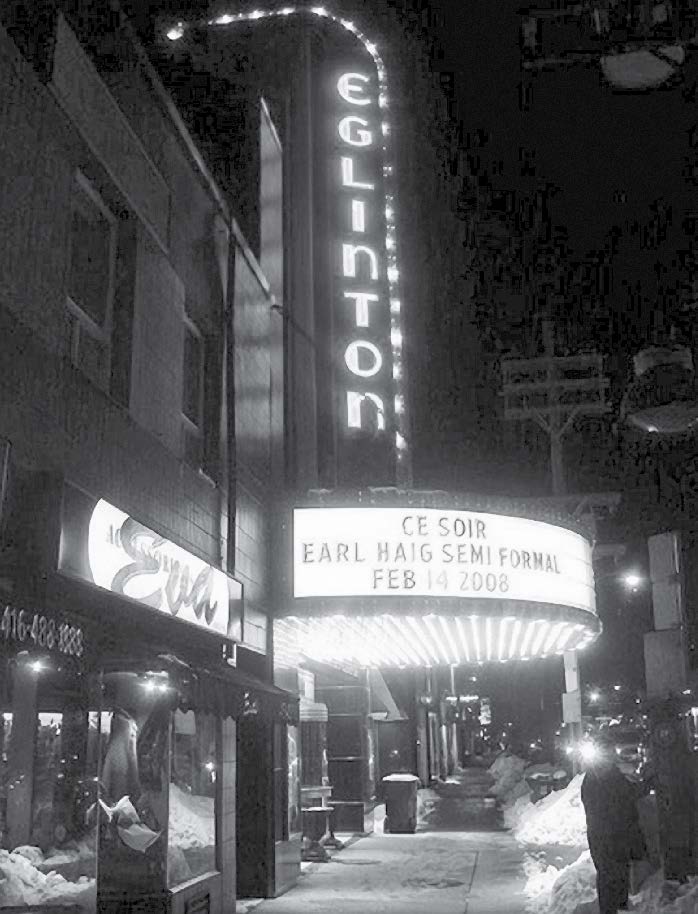
Back in the early 1950s, Toronto used to have over 130 neighborhood movie theatres, or “Nabes,” as they were affectionately known. Sadly, that number has dwindled to a mere handful today, but among those that remain is the Eglinton Theatre – although it no longer shows movies.
Opened to great fanfare in 1936, this gorgeous streamlined Art Deco showpiece was the flagship of the Famous Players national cinema chain until multiplex movie houses began to undermine is competitiveness and ultimately caused it to close its doors in 2002. Fearing its demolition, there was great pubic agitation that materialized into a private restoration and adaptive reuse of theatre into the Eglinton Grand, a rentable special events venue.
The Eglinton’s exterior is dominated by its beautiful façade and signage, the latter a futuristic-looking tower with a three- stage pylon crowned with a flashing neon ball. The interior also features neon lighting and more significantly, female nude statuary resting over the front exits on both sides of the movie screen that transfixed me as a teenage moviegoer. The statues were, of course, tastefully designed in a classical interpretation.
4: Sam the Record Man
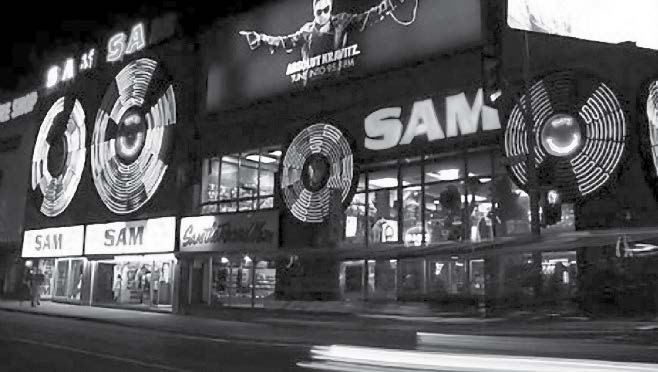
For any music lover in Toronto, Sam the Record Man was the place to shop – yes, was, because as of mid-2007, Sam’s had closed down, a victim of among other things online competition for music purchasing. Established in 1937 by Sam Snider- man, this Yonge Street address was opened in 1961 as a single shop which saw the installation of the first giant neon record sign in 1969. As Sam’s grew, it absorbed several neighboring stores and later added the second neon disc in 1987 and other smaller versions thereafter.
Sam’s was famous for its Boxing Day sales in the era when the day after Christmas was really the only legitimate “sale” day. Back in the 1980s, I submitted to those sales, trekking down Yonge to line up in the cold for far too long, only to get a chance at picking up the latest double-live fold-out lp set for a couple bucks off. Although it is farfetched to imagine doing this sort of thing today, it was a juvenile rite-of-passage back then.
Much of what made Sam’s interesting is precisely what Honest Ed’s has to offer today: creaky floors, a maze of aisles, and tons of autographed memorabilia (in this case, focused on the recording industry). Sadly, when Sam’s closed everything was put on the auction block – and had the city not intervened, that would have included the two giant neon disc signs. These landmark fixtures have been dismantled and will undergo restoration before being reinstalled and relit somewhere on the original site, now owned by the adjoining Ryerson University Campus.
5: The Goof
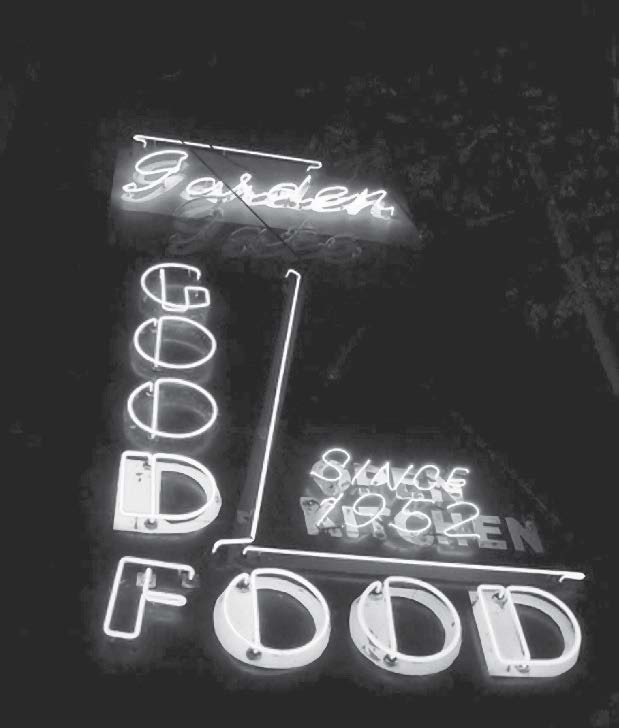
Diners in the fashionable Beach neighborhood on the city’s east end have a culinary treat in store if they partake of the Garden Gate Chinese Restaurant, nicknamed and universally referred to as “The Goof ” in memory of the passing era when the neon letter ‘D’ on one side of the GOOD FOOD logo was broken and unlit for quite some time. By culinary treat, I am speaking, of course, of greasy comfort food (Chinese and other predictable fare), which can be had for quite reasonable prices. Long-time patrons of this restaurant may shun its recent renovations which have done away with its dated yet alluring fifties décor, but the owners were smart enough to leave the vintage neon sign alone.
Did you enjoy this article? Join the SCA and get full access to all the content on this site. This article originally appeared in the SCA Road Notes, Winter 2008, Vol. 16, No. 4. SCA Road Notes, informally known as SCA News, is a quarterly publication and a member benefit of the Society for Commercial Archeology. Back issues are available for download.
More Articles Join the SCA


